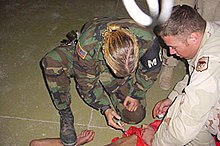|
Megan Ambuhl
Megan Ambuhl (born 1974 or 1975) is a former United States Army Reserve soldier who was convicted of dereliction of duty for her role in the prisoner abuse that occurred at Abu Ghraib prison, a notorious prison in Baghdad during the United States' occupation of Iraq. Early lifeAmbuhl was born in Centreville, Virginia.[1] She graduated from high school in 1992 and attended Coastal Carolina University, where she received an Associate of Science degree in biology.[1] Military serviceAmbuhl entered military service on January 31, 2002.[1] She attended One Station Unit Training at Fort Leonard Wood in Missouri, completing basic training around June 23, 2002.[1] After completing Military Occupational Specialty training, she was released from active duty on August 23, 2002.[1] In civilian life, Ambuhl was a histology technician at LabCorp in Herndon, Virginia.[1] Including Delayed Entry time, Ambuhl served in the United States Army Reserve for two years and nine months.[1] On February 21, 2003, Ambuhl was activated for service in the Iraq War.[1] In a stipulation made during court-martial proceedings, Ambuhl wrote that she "received Geneva Convention and UCMJ training during an approximately 60–90 minute block of instruction in basic training, but cannot remember any specifics of those classes."[1] Ambuhl was originally assigned to the 352nd Military Police Company, but was involuntarily transferred to the 372nd Military Police Company.[1] The 372nd Company spent three months training at Fort Lee, Virginia[1] on Law and Order Missions.[2] In May 2003, Ambuhl and the 372nd Company arrived in Kuwait, proceeding north to Al Hillah in Iraq, where the company "was responsible for, among other things, assisting and training the Iraqi Police in the surrounding area."[1] On October 15, 2003, the company assumed duties at the Baghdad Central Confinement Facility (BCCF, better known as the Abu Ghraib prison) 12 miles west of Baghdad.[1] Involvement in prisoner abuse From October 2003 to January 2004, Ambuhl worked at Abu Ghraib, primarily as a night shift guard for Tier 1B, which housed "certain sub-categories of civilian detainees – including women, juveniles, and detainees suspected of psychiatric/psychological problems or mental instability," as well as "detainees that had caused serious disciplinary problems."[1] Ambuhl's particular responsibility was to guard women and juveniles in Tier 1B.[1] The 372nd Company was not trained in internment and resettlement (IR).[1] In her stipulation, Ambuhl admitted that between October 20 and December 1, 2003, she was derelict of duty in that she had "willfully failed to protect Iraqi detainees from abuse, cruelty, and maltreatment."[1] Specifically, Ambuhl stipulated that she witnessed "numerous acts" of abuse, cruelty, and maltreatment, writing that "This time was very confusing for me, and things were done to detainees that I questioned, but that apparently were permissible. But there were some things that were done that I knew were wrong at the time, and I did not act to stop this behavior to protect the detainees."[1] Ambuhl was served with a court-martial in August 2004 in connection with prisoner abuse at Abu Ghraib. She was represented by a Washington, D.C.-based civilian lawyer, Harvey J. Volzer. A June 2004 Newsday article reported that Ambuhl, who had not yet appeared in any of the released photographs, was not involved in the incidents at Abu Ghraib:
In a Pittsburgh Post-Gazette article, Volzer was quoted as saying:
Ambuhl appears in several of the photos relating to the prisoner abuse at Abu Ghraib, published by Salon.com in March 2006,[5] observing the incidents of abuse[6] or administering injections.[7] However, none of the photographs published by Salon appear to show her directly engaged in prisoner abuse. As part of a plea agreement, Specialist Ambuhl was convicted by court-martial on October 30, 2004, for dereliction of duty. In punishment, she was demoted to Private, discharged from the Army, and docked half a month's pay. Additional charges brought against Ambuhl were dropped following a pretrial guilty plea but had included allegations of conspiracy, maltreatment, and indecent acts. She was the third MP reservist and fourth U.S. soldier convicted in the Abu Ghraib prisoner abuse scandal.[8][9] Marriage to Charles Graner In April 2005, she married Charles Graner, who was serving time for his role in the Abu Ghraib scandal. Graner had earlier been in a relationship with another soldier, Lynndie England and had one child with her. [10] Because Ambuhl was not permitted to see him for the first 2½ years of his incarceration, it was a proxy wedding.[11][12] From 2005 onwards, she ran the now-defunct website, www.supportmpscapegoats.com (archived link), where she posted documents in support of her husband's innocence. In a Washington Post web interview, she also stated: "[Graner] should be let out now because he and the others in prison have served more prison time than any other soldier sentenced for similar cases [...] including murders."[13] See also
References
External links
|
||||||||||||||